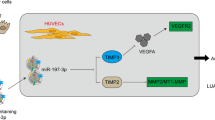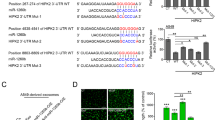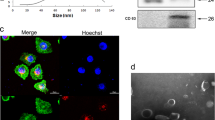Abstract
Tissue inhibitor of metalloproteinases-1 (TIMP-1) recently emerged as a pro-metastatic factor highly associated with poor prognosis in a number of cancers. This correlation seemed paradox as TIMP-1 is best described as an inhibitor of pro-tumourigenic matrix metalloproteinases. Only recently, TIMP-1 has been revealed as a signalling molecule that can regulate cancer progression independent of its inhibitory properties. In the present study, we demonstrate that an increase of both exogenous and endogenous TIMP-1 led to the upregulation of miR-210 in a CD63/PI3K/AKT/HIF-1-dependent pathway in lung adenocarcinoma cells. TIMP-1 induced P110/P85 PI3K-signalling and AKT phosphorylation. It also led to increase of HIF-1α protein levels positively correlating with HIF-1-regulated mRNA expression and upregulation of the microRNA miR-210. Downstream targets of miR-210, namely FGFRL1, E2F3, VMP-1, RAD52 and SDHD, were decreased in the presence of TIMP-1. Upon the overexpression of TIMP-1 in tumour cells, miR-210 was accumulated in exosomes in vitro and in vivo. These exosomes promoted tube formation activity in human umbilical vein endothelial cell (HUVECs), which was reflected in increased angiogenesis in A549L-derived tumour xenografts. Activation and elevation of PI3K, AKT, HIF-1A and miR-210 in tumours additionally confirmed our in vitro data. This new pro-tumourigenic signalling function of TIMP-1 may explain why elevated TIMP-1 levels in lung cancer patients are highly correlated with poor prognosis.
This is a preview of subscription content, access via your institution
Access options
Subscribe to this journal
Receive 50 print issues and online access
$259.00 per year
only $5.18 per issue
Buy this article
- Purchase on Springer Link
- Instant access to full article PDF
Prices may be subject to local taxes which are calculated during checkout








Similar content being viewed by others
References
Ferlay J, Shin H-R, Bray F, Forman D, Mathers C, Parkin DM . Estimates of worldwide burden of cancer in 2008: GLOBOCAN 2008. Int J Cancer 2010; 127: 2893–2917.
Hanahan D, Weinberg RA . Hallmarks of cancer: the next generation. Cell 2011; 144: 646–674.
Gupta GP, Massagué J . Cancer metastasis: building a framework. Cell 2006; 127: 679–695.
Krüger A, Kates RE, Edwards DR . Avoiding spam in the proteolytic internet: Future strategies for anti-metastatic MMP inhibition. Biochim Biophys Acta 2010; 1803: 95–102.
Brew K, Nagase H . The tissue inhibitors of metalloproteinases (TIMPs): an ancient family with structural and functional diversity. Biochim Biophys 2010; 1803: 55–71.
Murphy G . Tissue inhibitors of metalloproteinases. Genome Biol 2011; 12: 233.
Ries C . Cytokine functions of TIMP-1. Cell Mol Life Sci 2013; 71: 659–672.
Stetler-Stevenson WG . Tissue inhibitors of metalloproteinases in cell signaling: metalloproteinase-independent biological activities. Sci Signal 2008; 1: re6.
Cruz-Munoz W, Khokha R . The role of tissue inhibitors of metalloproteinases in tumorigenesis and metastasis. Crit Rev Clin Lab Sci 2008; 45: 291–338.
Kopitz C, Gerg M, Bandapalli OR, Ister D, Pennington CJ, Hauser S et al. Tissue inhibitor of metalloproteinases-1 promotes liver metastasis by induction of hepatocyte growth factor signaling. Cancer Res 2007; 67: 8615–8623.
Amour A, Knight C, Webster A, Slocombe P, Stephens P, Knäuper V et al. The in vitro activity of ADAM-10 is inhibited by TIMP-1 and TIMP-3. FEBS Lett 2000; 473: 275–279.
Rauvala M, Puistola U, Turpeenniemi-Hujanen T . Gelatinases and their tissue inhibitors in ovarian tumors; TIMP-1 is a predictive as well as a prognostic factor. Gynecol Oncol 2005; 99: 656–663.
Ylisirniö S, Höyhtyä M, Turpeenniemi-Hujanen T . Serum matrix metalloproteinases-2,-9 and tissue inhibitors of metalloproteinases-1,-2 in lung cancer—TIMP-1 as a prognostic marker. Anticancer Res 1999; 20: 1311–1316.
Ylisirniö S, Höyhtyä M, Mäkitaro R, Pääkkö P, Risteli J, Kinnula VL et al. Elevated serum levels of type I collagen degradation marker ICTP and tissue inhibitor of metalloproteinase (TIMP) 1 are associated with poor prognosis in lung cancer. Clin Cancer Res 2001; 7: 1633–1637.
Pesta M, Kulda V, Kucera R, Pesek M, Vrzalova J, Liska V et al. Prognostic significance of TIMP-1 in non-small cell lung cancer. Anticancer Res. 2011; 31: 4031–4038.
Wang CS, Wu TL, Tsao KC, Sun CF . Serum TIMP-1 in gastric cancer patients: a potential prognostic biomarker. Ann Clin Lab Sci 2006; 36: 23–30.
Ilie M, Lassalle S, Long-Mira E, Hofman V, Zangari J, Bénaim G et al. In papillary thyroid carcinoma, TIMP-1 expression correlates with BRAF (V600E) mutation status and together with hypoxia-related proteins predict aggressive behaviour. Virchows Arch 2013; 463: 437–444.
Jung K-K, Liu X-W, Chirco R, Fridman R, Kim H-RC . Identification of CD63 as a tissue inhibitor of metalloproteinase-1 interacting cell surface protein. EMBO J 2006; 25: 3934–3942.
Liu X-W, Bernardo MM, Fridman R, Kim H-RC . Tissue inhibitor of metalloproteinase-1 protects human breast epithelial cells against intrinsic apoptotic cell death via the focal adhesion kinase/phosphatidylinositol 3-kinase and MAPK signaling pathway. J Biol Chem 2003; 278: 40364–40372.
Taube ME, Liu XW, Fridman R, Kim HRC . TIMP-1 regulation of cell cycle in human breast epithelial cells via stabilization of p27KIP1 protein. Oncogene 2006; 25: 3041–3048.
Liu XW, Taube ME, Jung KK, Dong Z, Lee YJ, Roshy S et al. Tissue inhibitor of metalloproteinase-1 protects human breast epithelial cells from extrinsic cell death: a potential oncogenic activity of tissue inhibitor of metalloproteinase-1. Cancer Res 2005; 65: 898–906.
Li G, Fridman R, Kim HRC . Tissue inhibitor of metalloproteinase-1 inhibits apoptosis of human breast epithelial cells. Cancer Res 1999; 59: 6267–6275.
Schelter F, Halbgewachs B, Bäumler P, Neu C, Görlach A, Schrötzlmair F et al. Tissue inhibitor of metalloproteinases-1-induced scattered liver metastasis is mediated by hypoxia-inducible factor-1α. Clin Exp Metastasis 2011; 28: 91–99.
Semenza GL . Targeting HIF-1 for cancer therapy. Nat Rev Cancer 2003; 3: 721–732.
Wilczynski J, Duechler M, Czyz M . Targeting NF-κB and HIF-1 pathways for the Treatment of cancer: part II. Arch Immunol Ther Exp (Warsz) 2011; 2011: 301–307.
Lando D, Peet DJ, Whelan DA, Gorman JJ, Whitelaw ML . Asparagine hydroxylation of the HIF transactivation domain: a hypoxic switch. Science 2002; 295: 858–861.
Kaelin WG Jr, Ratcliffe PJ . Oxygen sensing by metazoans: the central role of the HIF hydroxylase pathway. Mol Cell 2008; 30: 393–402.
Jaakkola P, Mole DR, Tian YM, Wilson MI, Gielbert J, Gaskell SJ et al. Targeting of HIF-α to the von Hippel-Lindau ubiquitylation complex by O2-regulated prolyl hydroxylation. Science 2001; 292: 468–472.
Chan YC, Banerjee J, Choi SY, Sen CK . miR-210: the master hypoxamir. Microcirculation 2012; 19: 215–223.
Chan SY, Loscalzo J . MicroRNA-210: a unique and pleiotropic hypoxamir. Cell Cycle 2010; 9: 1072–1083.
Huang X, Ding L, Bennewith KL, Tong RT, Welford SM, Ang KK et al. Hypoxia-inducible mir-210 regulates normoxic gene expression involved in tumor initiation. Mol Cell 2009; 35: 856–867.
Fasanaro P, D'Alessandra Y, Di Stefano V, Melchionna R, Romani S, Pompilio G et al. MicroRNA-210 modulates endothelial cell response to hypoxia and inhibits the receptor tyrosine kinase ligand Ephrin-A3. J Biol Chem 2008; 283: 15878–15883.
Alaiti MA, Ishikawa M, Masuda H, Simon DI, Jain MK, Asahara T et al. Up-regulation of miR-210 by vascular endothelial growth factor in ex vivo expanded CD34+ cells enhances cell-mediated angiogenesis. J Cell Mol Med 2012; 16: 2413–2421.
Giannakakis A, Sandaltzopoulos R, Greshock J, Liang S, Huang J, Hasegawa K et al. miR-210 links hypoxia with cell cycle regulation and is deleted in human epithelial ovarian cancer. Cancer Biol Ther 2008; 7: 255–264.
Kim HW, Haider HK, Jiang S, Ashraf M . Ischemic preconditioning augments survival of stem cells via miR-210 expression by targeting caspase-8-associated protein 2. J Biol Chem 2009; 284: 33161–33168.
Noman MZ, Buart S, Romero P, Ketari S, Janji B, Mari B et al. Hypoxia-inducible miR-210 regulates the susceptibility of tumor cells to lysis by cytotoxic T cells. Cancer Res 2012; 72: 4629–4641.
Zhang Z, Sun H, Dai H, Walsh R, Imakura M, Schelter J et al. MicroRNA miR-210 modulates cellular response to hypoxia through the MYC antagonist MNT. Cell Cycle 2009; 8: 2756–2768.
Puissegur MP, Mazure NM, Bertero T, Pradelli L, Grosso S, Robbe-Sermesant K et al. miR-210 is overexpressed in late stages of lung cancer and mediates mitochondrial alterations associated with modulation of HIF-1 activity. Cell Death Differ 2010; 18: 465–478.
Kelly TJ, Souza AL, Clish CB, Puigserver P . A hypoxia-induced positive feedback loop promotes hypoxia-inducible factor 1-alpha stability through miR-210 suppression of glycerol-3-phosphate dehydrogenase 1-like. Mol Cell Biol 2011; 31: 2696–2706.
Wang A, Flach H, Onizawa M, Wei L, McManus M, Weiss A . Negative regulation of Hif1a expression and TH17 differentitation by the hypoxia-regulated microRNA miR-210. Nat Immunol 2014; 15: 393–401.
Semenza GL . HIF-1: upstream and downstream of cancer metabolism. Curr Opin Genet Dev 2010; 20: 51–56.
King H, Michael M, Gleadle J . Hypoxic enhancement of exosome release by breast cancer cells. BMC Cancer 2012; 12: 421–431.
Shimoda M, Khokha R . Proteolytic factors in exosomes. Proteomics 2013; 13: 1624–1636.
Bobrie A, Colombo M, Raposo G, Théry C . Exosome secretion: molecular mechanisms and roles in immune responses. Traffic 2011; 12: 1659–1668.
Valadi H, Ekström K, Bossios A, Sjöstrand M, Lee JJ, Lötvall JO . Exosome-mediated transfer of mRNAs and microRNAs is a novel mechanism of genetic exchange between cells. Nat Cell Biol 2007; 9: 654–659.
Kucharzewska P, Christianson HC, Welch JE, Svensson KJ, Fredlund E, Ringnér M et al. Exosomes reflect the hypoxic status of glioma cells and mediate hypoxia-dependent activation of vascular cells during tumor development. Proc Natl Acad Sci USA 2013; 110: 7312–7317.
Tsuchiya S, Fujiwara T, Sato F, Shimada Y, Tanaka E, Sakai Y et al. MicroRNA-210 regulates cancer cell proliferation through targeting fibroblast growth factor receptor-like 1 (FGFRL1). J Biol Chem 2011; 286: 420–428.
Ying Q, Liang L, Guo W, Zha R, Tian Q, Huang S et al. Hypoxia-inducible miR-210 augments the metastatic potential of tumor cells by targeting VMP1 in hepatocellular carcinoma. Hepatology 2011; 54: 2064–2075.
Crosby ME, Kulshreshtha R, Ivan M, Glazer PM . MicroRNA regulation of DNA repair gene expression in hypoxic stress. Cancer Res 2009; 69: 1221–1229.
Murphy G, Houbrechts A, Cockett MI, Williamson RA, O'Shea M, Docherty AJP . The N-terminal domain of tissue inhibitor of metalloproteinases retains metalloproteinase inhibitory activity. Biochemistry 1991; 30: 8097–8102.
Nagase H, Brew K . Engineering of tissue inhibitor of metalloproteinases mutants as potential therapeutics. Arthritis Res 2002; 4: S51–S61.
Jung Y, Liu X, Chirco R, Warner R, Fridman R, Kim H . TIMP-1 induces an EMT-like phenotypic conversion in MDCK cells independent of its MMP-inhibitory domain. PLoS ONE 2012; 7: e38773.
Lu Y, Liu S, Zhang S, Cai G, Jiang H, Su H et al. Tissue inhibitor of metalloproteinase-1 promotes NIH3T3 fibroblast proliferation by activating p-Akt and cell cycle progression. Mol Cells 2011; 31: 225–230.
Huang X, Le Q-T, Giaccia AJ . MiR-210-micromanager of the hypoxia pathway. Trends Mol Med 2010; 16: 230–237.
Rabinowits G, Gercel-Taylor C, Day JM, Taylor DD, Kloecker GH . Exosomal microRNA: a diagnostic marker for lung cancer. Clin Lung Cancer 2009; 10: 42–46.
Yanaihara N, Caplen N, Bowman E, Seike M, Kumamoto K, Yi M et al. Unique microRNA molecular profiles in lung cancer diagnosis and prognosis. Cancer Cell 2006; 9: 189–198.
Ohshima K, Inoue K, Fujiwara A, Hatakeyama K, Kanto K, Watanabe Y et al. Let-7 microRNA familiy is selectively secreted into the extracellular environment via exosomes in a metastatic gastric cancer cell line. PLoS ONE 2010; 5: e13247.
Park JE, Tan HS, Datta A, Lai RC, Zhang H, Meng W et al. Hypoxic tumor cell modulates its microenvironment to enhance angiogenic and metastatic potential by secretion of proteins and exosomes. Mol Cell Proteomics 2010; 9: 1085–1099.
Gouyer Vr, Conti M, Devos P, Zerimech F, Copin MC, Créme E et al. Tissue inhibitor of metalloproteinase 1 is an independent predictor of prognosis in patients with nonsmall cell lung carcinoma who undergo resection with curative intent. Cancer 2005; 103: 1676–1684.
Cui H, Grosso S, Schelter F, Mari B, Krüger A . On the pro-metastatic stress response to cancer therapies: evidence for a positive co-operation between TIMP-1, HIF-1alpha, and miR-210. Front Pharmacol 2012; 3: 134.
Nagase H, Visse R, Murphy G . Structure and function of matrix metalloproteinases and TIMPs. Cardiovasc Res 2006; 69: 562–573.
Liu H, Chen B, Lilly B . Fibroblasts potentiate blood vessel formation partially through secreted factor of TIMP-1. Angiogenesis 2008; 11: 223–234.
Yoshiji H, Harris SR, Raso E, Gomez DE, Lindsay CK, Shibuya M et al. Mammary carcinoma cells over-expressing tissue inhibitor of metalloproteinases-1 show enhanced vascular endothelial growth factor expression. Int J Cancer 1998; 5: 81–87.
de Lorenzo MS, Ripoll GV, Yoshiji H, Yamazaki M, Thorgeirsson UP, Alonso DF et al. Altered tumor angiogenesis and metastasis of B16 melanoma in transgenic mice overexpressing tissue inhibitor of metalloproteinases-1. In vivo 2003; 17: 45–50.
Salomon C, Ryan J, Sobrevia L, Kobayashi M, Ashman K, Mitchell M et al. Exosomal signaling during hypoxia mediates microvascular endothelial cell migration and vasculogenesis. PloS ONE 2013; 8: e68451.
Xiao F, Qiu H, Zhou L, Shen X, Yang L, Ding K . WSS25 inhibits Dicer, downregulating microRNA-210, which targets Ephrin-A3, to suppress human microvascular endothelial cells (HMEC-1) tube formation. Glycobiology 2013; 23: 524–535.
Ghajar C, Peinado H, Mori H, Matei I, Evason K, Brazier H et al. The perivascular niche regulates breast tumour dormancy. Nat Cell Biol 2013; 15: 807–817.
Xia Y, Yeddula N, Leblanc M, Ke E, Zhang Y, Oldfield E et al. Reduced cell proliferation by IKK2 depletion in a mouse lung-cancer model. Nat Cell Biol 2012; 14: 257–265.
Majmundar AJ, Wong WJ, Simon MC . Hypoxia-inducible factors and the response to hypoxic stress. Mol Cell 2010; 40: 294–309.
Chan SY, Zhang YY, Hemann C, Mahoney CE, Zweier JL, Loscalzo J . MicroRNA-210 controls mitochondrial metabolism during hypoxia by repressing the iron-sulfur cluster assembly proteins ISCU1/2. Cell Metab 2009; 10: 273–284.
Grosso S, Doyen J, Parks SK, Bertero T, Paye A, Cardinaud B et al. MiR-210 promotes a hypoxic phenotype and increases radioresistance in human lung cancer cell lines. Cell Death Dis 2013; 4: e544.
Wilson WR, Hay MP . Targeting hypoxia in cancer therapy. Nat Rev Cancer 2011; 11: 393–410.
Hauser S, Bickel L, Weinspach D, Gerg M, Schäfer MK, Pfeifer M et al. Full-length L1CAM and not its delta2delta27 splice variant promotes metastasis through induction of gelatinase expression. PLoS One 2011; 6: e18989.
Schambach A, Mueller D, Galla M, Verstegen MMA, Wagemaker G, Loew R et al. Overcoming promoter competition in packaging cells improves production of self-inactivating retroviral vectors. Gene Ther 2006; 13: 1524–1533.
Lässer C, Eldh M, Lötvall J . Isolation and characterization of RNA-containing exosomes. J Vis Exp 2012. e3037.
Arnaoutova I, Kleinman HK . In vitro angiogenesis: endothelial cell tube formation on gelled basement membrane extract. Nature Protoc 2010; 5: 628–635.
Acknowledgements
We thank Katja Honert for expert technical assistance in cell culture experiments and Susanne Schaten for immunohistochemical advice. We are grateful to Carolin Wander for cloning pRRL.PPT.SF.CD63-mCherry and Dominik Alterauge for cloning pRRL.PPT.SF.N-TIMP-1 and pRRL.PPT.SF.TIMP-1_T2G. We thank Georg Sedlmeier for help with experiments regarding the TIMP-1 variants. Financial support came from the Deutsche Forschungsgesellschaft KR2047/1-2 and KR2047/3-1 to AK.
Author information
Authors and Affiliations
Corresponding author
Additional information
Supplementary Information accompanies this paper on the Oncogene website
Supplementary information
Rights and permissions
About this article
Cite this article
Cui, H., Seubert, B., Stahl, E. et al. Tissue inhibitor of metalloproteinases-1 induces a pro-tumourigenic increase of miR-210 in lung adenocarcinoma cells and their exosomes. Oncogene 34, 3640–3650 (2015). https://doi.org/10.1038/onc.2014.300
Received:
Revised:
Accepted:
Published:
Issue Date:
DOI: https://doi.org/10.1038/onc.2014.300
This article is cited by
-
Metabolomic investigation of urinary extracellular vesicles for early detection and screening of lung cancer
Journal of Nanobiotechnology (2023)
-
MiR-1246b, a novel miRNA molecule of extracellular vesicles in bronchoalveolar lavage fluid, promotes nodule growth through FGF14 in patients with lung cancer
Cell Death & Disease (2023)
-
Gene expression related to lung cancer altered by PHMG-p treatment in PBTE cells
Molecular & Cellular Toxicology (2023)
-
The therapeutic potential of exosomes in lung cancer
Cellular Oncology (2023)
-
Timp1 Deletion Induces Anxiety-like Behavior in Mice
Neuroscience Bulletin (2023)



